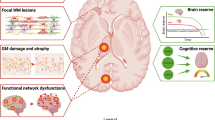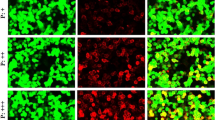Abstract
Systemic lupus erythematosus (SLE) is a multisystem autoimmune disease, in which neuropsychiatric manifestations are a common cause of significant morbidity. The American College of Rheumatology has identified 19 distinct neuropsychiatric syndromes associated with SLE, although the 1982 American College of Rheumatology classification criteria for SLE recognize only two: seizures and psychosis. Neurocognitive impairment (NCI) is one of the most common and clinically challenging manifestations of SLE, but its pathophysiology remains poorly understood. This Review examines the epidemiology and pathophysiology of NCI in children and adolescents with SLE, as well as the diagnostic and therapeutic approaches that are available for these patients. As few published studies specifically address NCI in pediatric SLE, new directions for research are also discussed.
This is a preview of subscription content, access via your institution
Access options
Subscribe to this journal
Receive 12 print issues and online access
$209.00 per year
only $17.42 per issue
Buy this article
- Purchase on Springer Link
- Instant access to full article PDF
Prices may be subject to local taxes which are calculated during checkout
Similar content being viewed by others
References
The American College of Rheumatology (1999) The American College of Rheumatology nomenclature and case definitions for neuropsychiatric lupus syndromes. Arthritis Rheum 42: 599–608
Sibbitt WL Jr et al. (2002) The incidence and prevalence of neuropsychiatric syndromes in pediatric onset systemic lupus erythematosus. J Rheumatol 29: 1536–1542
Hiraki LT et al. (2008) Clinical and laboratory characteristics and long-term outcome of pediatric systemic lupus erythematosus: a longitudinal study. J Pediatr 152: 550–556
Brunner HI et al. (2007) Initial validation of the Pediatric Automated Neuropsychological Assessment Metrics for childhood-onset systemic lupus erythematosus. Arthritis Rheum 57: 1174–1182
Mikdashi JA et al. (2007) Proposed response criteria for neurocognitive impairment in systemic lupus erythematosus clinical trials. Lupus 16: 418–425
Ainiala H et al. (2001) The prevalence of neuropsychiatric syndromes in systemic lupus erythematosus. Neurology 57: 496–500
Glanz BI et al. (1997) Pattern of neuropsychologic dysfunction in inactive systemic lupus erythematosus. Neuropsychiatry Neuropsychol Behav Neurol 10: 232–238
Denburg SD et al. (1987) Cognitive impairment in systemic lupus erythematosus: a neuropsychological study of individual and group deficits. J Clin Exp Neuropsychol 9: 323–339
Kozora E et al. (1996) Analysis of cognitive and psychological deficits in systemic lupus erythematosus patients without overt central nervous system disease. Arthritis Rheum 39: 2035–2045
Shucard JL et al. (2004) Working memory and processing speed deficits in systemic lupus erythematosus as measured by the paced auditory serial addition test. J Int Neuropsychol Soc 10: 35–45
Ginsburg KS et al. (1992) A controlled study of the prevalence of cognitive dysfunction in randomly selected patients with systemic lupus erythematosus. Arthritis Rheum 35: 776–782
Hanly JG et al. (1992) Cognitive impairment in patients with systemic lupus erythematosus. J Rheumatol 19: 562–567
McLaurin EY et al. (2005) Predictors of cognitive dysfunction in patients with systemic lupus erythematosus. Neurology 64: 297–303
Harel L et al. (2006) Neuropsychiatric manifestations in pediatric systemic lupus erythematosus and association with antiphospholipid antibodies. J Rheumatol 33: 1873–1877
Avcin T et al. (2008) A followup study of antiphospholipid antibodies and associated neuropsychiatric manifestations in 137 children with systemic lupus erythematosus. Arthritis Rheum 59: 206–213
Emori A et al. (2005) Cognitive dysfunction in systemic lupus erythematosus. Psychiatry Clin Neurosci 59: 584–589
Benedict RH et al. (2008) Neuropsychological impairment in systemic lupus erythematosus: a comparison with multiple sclerosis. Neuropsychol Rev 18: 149–166
Carbotte RM et al. (1995) Cognitive deficit associated with rheumatic diseases: neuropsychological perspectives. Arthritis Rheum 38: 1363–1374
Wyckoff PM et al. (1995) Neuropsychological assessment of children and adolescents with systemic lupus erythematosus. Lupus 4: 217–220
Ardoin SP et al. (2008) Retrospective analysis of neurocognitive testing in children and adolescents with SLE. Arthritis Rheum (in press)
Filley CM (2005) White matter and behavioral neurology. Ann NY Acad Sci 1064: 162–183
Filley CM (1998) The behavioral neurology of cerebral white matter. Neurology 50: 1535–1540
Luna B et al. (2004) Maturation of cognitive processes from late childhood to adulthood. Child Dev 75: 1357–1372
Luna B and Sweeney JA (2001) Studies of brain and cognitive maturation through childhood and adolescence: a strategy for testing neurodevelopmental hypotheses. Schizophr Bull 27: 443–455
Korkman M et al. (2001) Effects of age on neurocognitive measures of children ages 5 to 12: a cross-sectional study on 800 children from the United States. Dev Neuropsychol 20: 331–354
Devinsky O et al. (1988) Clinical and neuropathological findings in systemic lupus erythematosus: the role of vasculitis, heart emboli, and thrombotic thrombocytopenic purpura. Ann Neurol 23: 380–384
Ellis SG and Verity MA (1979) Central nervous system involvement in systemic lupus erythematosus: a review of neuropathologic findings in 57 cases, 1955–1977. Semin Arthritis Rheum 8: 212–221
Kang EH et al. (2008) Flow cytometric assessment of anti-neuronal antibodies in central nervous system involvement of systemic lupus erythematosus and other autoimmune diseases. Lupus 17: 21–25
Papero PH et al. (1990) Neuropsychologic deficits and antineuronal antibodies in pediatric systemic lupus erythematosus. Clin Exp Rheumatol 8: 417–424
Zandman-Goddard G et al. (2007) Autoantibodies involved in neuropsychiatric SLE and antiphospholipid syndrome. Semin Arthritis Rheum 36: 297–315
Benseler SM and Silverman ED (2007) Neuropsychiatric involvement in pediatric systemic lupus erythematosus. Lupus 16: 564–571
Toubi E and Shoenfeld Y (2007) Clinical and biological aspects of anti-P-ribosomal protein autoantibodies. Autoimmun Rev 6: 119–125
Katzav A et al. (2007) Induction of autoimmune depression in mice by anti-ribosomal P antibodies via the limbic system. Arthritis Rheum 56: 938–948
Hanly JG et al. (1999) A prospective analysis of cognitive function and anticardiolipin antibodies in systemic lupus erythematosus. Arthritis Rheum 42: 728–734
DeGiorgio LA et al. (2001) A subset of lupus anti-DNA antibodies cross-reacts with the NR2 glutamate receptor in systemic lupus erythematosus. Nat Med 7: 1189–1193
Kowal C et al. (2004) Cognition and immunity; antibody impairs memory. Immunity 21: 179–188
Yoshio T et al. (2006) Association of IgG anti-NR2 glutamate receptor antibodies in cerebrospinal fluid with neuropsychiatric systemic lupus erythematosus. Arthritis Rheum 54: 675–678
Levy D (2007) Anti-NR-2 antibodies are prevalent in childhood-onset SLE (cSLE), but do not predict neurocognitive dysfunction [abstract]. Arthritis Rheum 55: S143
Iikuni N et al. (2006) Raised monocyte chemotactic protein-1 (MCP-1)/CCL2 in cerebrospinal fluid of patients with neuropsychiatric lupus. Ann Rheum Dis 65: 253–256
Fragoso-Loyo H et al. (2007) Interleukin-6 and chemokines in the neuropsychiatric manifestations of systemic lupus erythematosus. Arthritis Rheum 56: 1242–1250
Hanly JG et al. (2005) Neuropsychiatric syndromes in patients with systemic lupus erythematosus and rheumatoid arthritis. J Rheumatol 32: 1459–1466
Ouvrier RA et al. (1993) The value of the Mini-Mental State Examination in childhood: a preliminary study. J Child Neurol 8: 145–148
Brunner HI et al. (2008) Standardizing the neuropsychological evaluation of children with SLE [abstract]. Lupus 17: 467
Levy DM et al. (2007) Neurocognitive function in childhood-onset systemic lupus erythematosus [abstract]. Arthritis Rheum 56: S368
Reeves DL et al. (2007) ANAM genogram: historical perspectives, description, and current endeavors. Arch Clin Neuropsychol 22 (Suppl 1): S15–S37
Kane RL et al. (2007) Identifying and monitoring cognitive deficits in clinical populations using Automated Neuropsychological Assessment Metrics (ANAM) tests. Arch Clin Neuropsychol 22 (Suppl 1): S115–S126
Roebuck-Spencer TM et al. (2006) Use of computerized assessment to predict neuropsychological functioning and emotional distress in patients with systemic lupus erythematosus. Arthritis Rheum 55: 434–441
Holliday SL et al. (2003) Validating a computerized neuropsychological test battery for mixed ethnic lupus patients. Lupus 12: 697–703
Sibbitt WL Jr et al. (1999) Neuroimaging in neuropsychiatric systemic lupus erythematosus. Arthritis Rheum 42: 2026–2038
Jennings JE et al. (2004) Value of MRI of the brain in patients with systemic lupus erythematosus and neurologic disturbance. Neuroradiology 46: 15–21
Ainiala H et al. (2005) Cerebral MRI abnormalities and their association with neuropsychiatric manifestations in SLE: a population-based study. Scand J Rheumatol 34: 376–382
Kozora E et al. (1998) Magnetic resonance imaging abnormalities and cognitive deficits in systemic lupus erythematosus patients without overt central nervous system disease. Arthritis Rheum 41: 41–47
Kao CH et al. (1999) The role of FDG-PET, HMPAO-SPET and MRI in the detection of brain involvement in patients with systemic lupus erythematosus. Eur J Nucl Med 26: 129–134
Weiner SM et al. (2000) Diagnosis and monitoring of central nervous system involvement in systemic lupus erythematosus: value of F-18 fluorodeoxyglucose PET. Ann Rheum Dis 59: 377–385
Sabbadini MG et al. (1999) Central nervous system involvement in systemic lupus erythematosus patients without overt neuropsychiatric manifestations. Lupus 8: 11–19
Waterloo K et al. (2001) Neuropsychological dysfunction in systemic lupus erythematosus is not associated with changes in cerebral blood flow. J Neurol 248: 595–602
Kozora E et al. (2005) Cognition, MRS neurometabolites, and MRI volumetrics in non-neuropsychiatric systemic lupus erythematosus: preliminary data. Cogn Behav Neurol 18: 159–162
Brooks WM et al. (1999) Relationship between neurometabolite derangement and neurocognitive dysfunction in systemic lupus erythematosus. J Rheumatol 26: 81–85
Bosma GP et al. (2000) Detection of cerebral involvement in patients with active neuropsychiatric systemic lupus erythematosus by the use of volumetric magnetization transfer imaging. Arthritis Rheum 43: 2428–2436
Rovaris M et al. (2000) Brain involvement in systemic immune mediated diseases: magnetic resonance and magnetisation transfer imaging study. J Neurol Neurosurg Psychiatry 68: 170–177
Emmer BJ et al. (2006) Detection of change in CNS involvement in neuropsychiatric SLE: a magnetization transfer study. J Magn Reson Imaging 24: 812–816
Emmer BJ et al. (2008) Correlation of magnetization transfer ratio histogram parameters with neuropsychiatric systemic lupus erythematosus criteria and proton magnetic resonance spectroscopy: association of magnetization transfer ratio peak height with neuronal and cognitive dysfunction. Arthritis Rheum 58: 1451–1457
DiFrancesco MW et al. (2007) Functional magnetic resonance imaging assessment of cognitive function in childhood-onset systemic lupus erythematosus: a pilot study. Arthritis Rheum 56: 4151–4163
Naqibuddin M et al. (2007) Memantine in systemic lupus erythematosus: a randomized double-blind, placebo-controlled trial [abstract]. Arthritis Rheum 56 (Suppl 9): S528
Harrison MJ et al. (2005) Results of intervention for lupus patients with self-perceived cognitive difficulties. Neurology 65: 1325–1327
Acknowledgements
This publication was made possible by Grant Number 5K23AR53202 from National Institutes of Arthritis and Musculoskeletal and Skin Diseases.
Désirée Lie, University of California, Irvine, CA, is the author of and is solely responsible for the content of the learning objectives, questions and answers of the Medscape-accredited continuing medical education activity associated with this article.
Author information
Authors and Affiliations
Corresponding author
Ethics declarations
Competing interests
The authors declare no competing financial interests.
Rights and permissions
About this article
Cite this article
Levy, D., Ardoin, S. & Schanberg, L. Neurocognitive impairment in children and adolescents with systemic lupus erythematosus. Nat Rev Rheumatol 5, 106–114 (2009). https://doi.org/10.1038/ncprheum0988
Received:
Accepted:
Issue Date:
DOI: https://doi.org/10.1038/ncprheum0988
This article is cited by
-
Neurophysiological evaluation of juvenile systemic lupus erythematosus
Egyptian Rheumatology and Rehabilitation (2022)
-
Integrative neuroscience approach to neuropsychiatric lupus
Immunologic Research (2015)
-
Chance, genetics, and the heterogeneity of disease and pathogenesis in systemic lupus erythematosus
Seminars in Immunopathology (2014)
-
Depression with psychotic features in a child with SLE: successful therapy with psychotropic medications—case report
European Child & Adolescent Psychiatry (2013)



